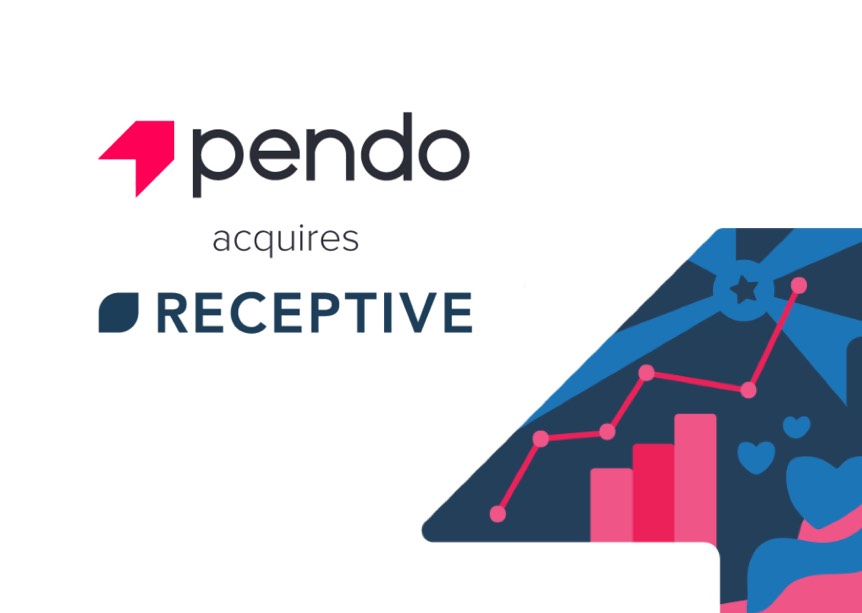Welcome to The Feedback Loop, it’s a bit like The Twilight Zone only less weird. We put two Receptive clients (one old, one new) in a virtual room together so that the newbies can gain insights into how to make the most of Receptive from those who have been there, done it, and got the t-shirt.*
*T-shirt may not exist.
.png)
In this episode, Aly spoke with Joey Marchy and Tiffany Brower from SS&C Advent Black Diamond, and Travis Nisbett from DaVita Kidney Care. Travis was unsure about how best to roll out Receptive internally, and so Joey and Tiffany were on hand to share some advice.
You can listen to the episode here:
Or read the highlights below.
Skip to:
-
To what extent did you set up your Receptive account before the launch?
-
If you re-launched today, what is the one resource you would prepare?
Why did you originally choose Receptive to manage your product feedback?
Joey: Managing ideas and feedback from our clients has always been quite a job.
We had ten different input channels or ways that clients could send us ideas on how to improve the product. We aggregated all of that stuff manually in Excel spreadsheets and there was no real way for us to allow clients to see the ideas that they submitted, track them, understand when the status changed, and most importantly when they were released. Many clients would send in ideas and it was just a black hole so they would never get any updates on the ideas after we built it, or if we didn’t want to build it.
We were in search of a product that could help us streamline all this information and bring more of a technology solution to the way we were handling it. That was one of the reasons why we chose Receptive. It’s really helped us manage that process.
We were in search of a product that could help us streamline all this information and bring more of a technology solution to the way we were handling it. That was one of the reasons why we chose Receptive. It’s really helped us manage that process.
When you launched Receptive last year, what did you do to get your team members and customers on board?
Joey: One of the things that we did was that we planned a pilot phase with our team. That was really important to us and it really gave us a lot of great learnings. If we hadn’t done the pilot when we rolled out the product we would have had so many questions that we hadn’t considered, and so many factors that we hadn’t thought about.
Tiffany: It’s just nice to get some other people’s perspectives.
Aly and the Receptive team do a great job of planning out what you need to be aware of, but just having someone who’s on the service side sharing some input of, “Oh well our customers don’t talk to us in this way,” or, “They would be wary of submitting an idea this way.”
We wanted to meld it with the current process as smoothly as possible so that it wasn’t a huge transition for our customer base and on the same side within our internal teams as well.
Joey: Yeah and that is one unique thing about our business. A lot of times our product managers do not interface directly with the clients when they’re receiving ideas. It really comes from our service team, so our service team is the point of contact for all of our clients. Whenever we onboard a new client they get designated a client advocate, someone that can answer your questions, someone that can field your feedback. So we really have this tiered model of receiving ideas, and those ideas would come in through the service team.
We needed to make sure that the service team understood what Receptive was, how they could communicate it to their clients, and so they managed that aspect of it, the idea intake. Then we had to also communicate to our product managers how they are going to do the prioritization, how they manage ideas when they come in, what our SLAs should be in terms of responding to ideas.
We really have two audiences that we have to communicate to.
An internal pilot phase really helped us get our teams familiar with the idea submission process, the review process, and try to break it down for us.
What was the biggest challenge?
Joey: Our biggest challenge was managing the change with the team because it was changing one of their workflows that they were used to and very comfortable with.
How did the pilot phase help with that?
Tiffany: The way that we approached the launch was with an internal pilot phase which really helped us get our teams familiar with the idea submission process, the review process, and try to break it down for us.
We have a couple of different cohorts within our internal teams. We have the service and implementation team, and within that group we have managers of those service teams. So we introduced it to the service team managers first, and talked about how we would approach this new tool with our clients, what their perception was, and what their concerns were.
Clients would soon be able to see other clients’ ideas so we needed to start educating everyone that you can’t share personal financial information anymore. It has to be more general.
When any idea was submitted to the service managers from a client we asked them to input them into Receptive instead of the old workflow. We asked ourselves:
-
What were we missing on that intake?
-
What extra information needs to be gathered?
Then we introduced that same idea to the product managers. Now that these ideas have been entered by our service team, we asked them:
-
What information are you guys missing to triage these ideas?
-
Do you need more information?
-
Do you want us to add some more required fields like a product that this is associated with?
With this information we were able to identify gaps and address those in our rollout documentation.
Joey: Initially it was a very “concierge” type approach where we handled a lot of the input into Receptive manually.
Receptive has a feature where you can add an idea on behalf of the client and one of the things that we did have to do before we started our pilot is we had to load all of our client accounts. When a client did submit an idea we could add it on behalf of them so that when our pilot phase was over and we rolled out publicly to our clients they would see their ideas that we added.
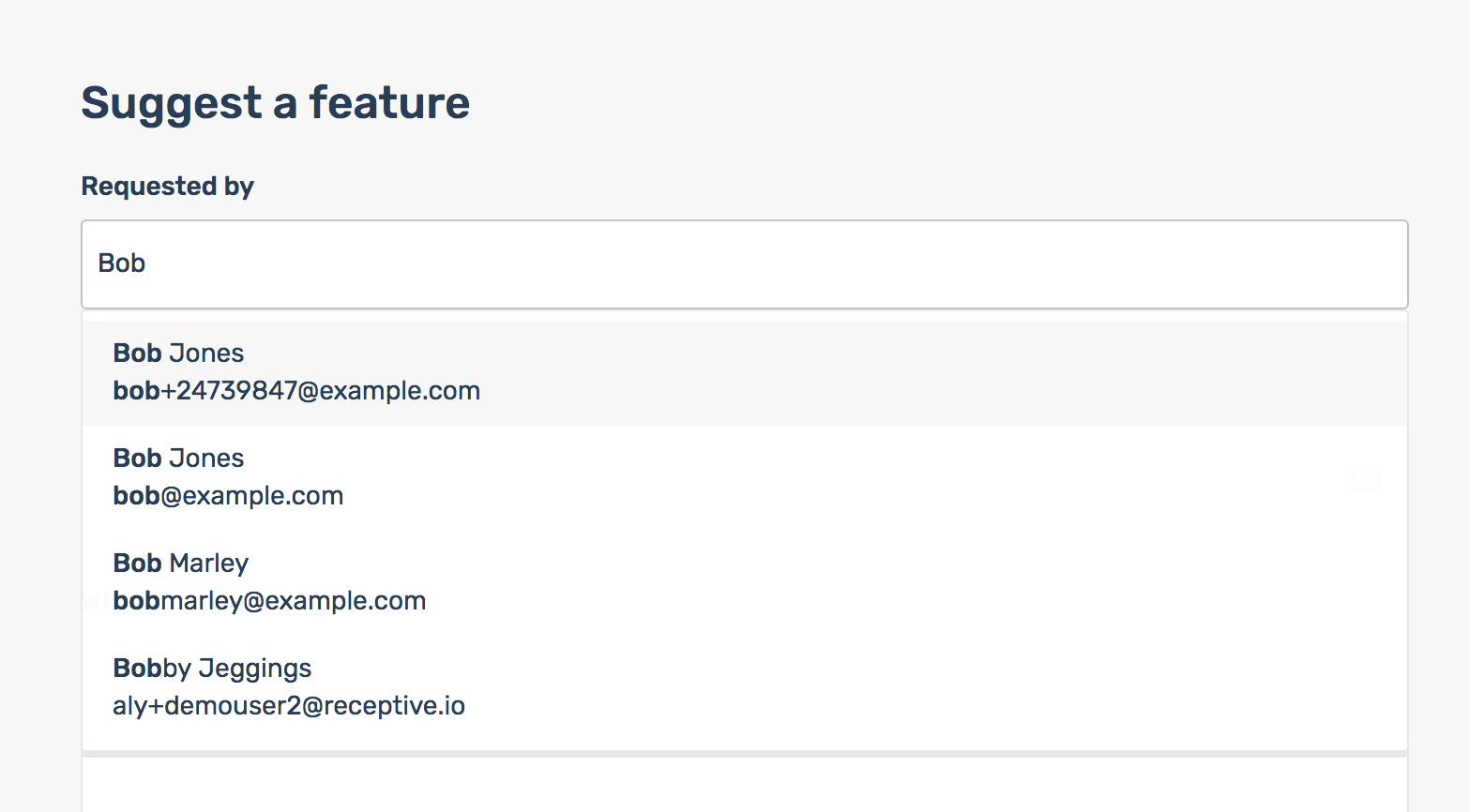 Adding an idea on behalf of a customer
Adding an idea on behalf of a customer
Tiffany: But we made sure that those clients wouldn’t get notified until we wanted them to be notified.
Joey: One other very kind of crucial thing that we were able to do with the pilot was a retrospective on the process. We sat down with our teams and we listened to the things that they thought were difficult and the things that they thought were easy. We took all the things that were difficult and we used that to build documentation and a user guide for our internal teams on how they should be using Receptive in their day to day work.
Tiffany: And within that user guide we actually found we built this massive document that spelled out everything. As helpful as that was, and though we thought we were covering all of our bases, people didn’t have time to sit down and read a 2-4 page document.
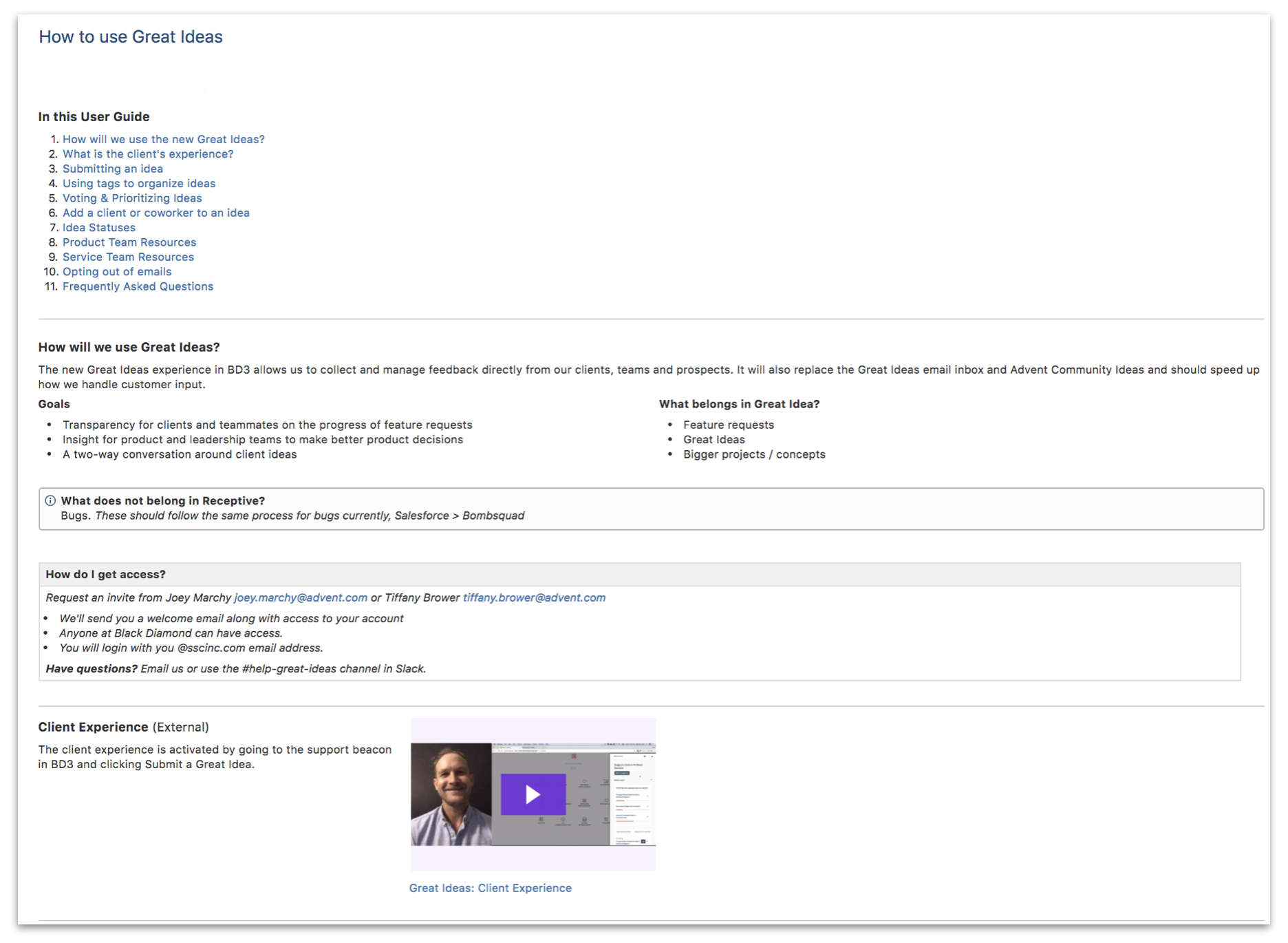
Black Diamond used their phased rollout to develop this in-depth team guide.
We had to adjust our roll out communication plan and send those steps in segments. We broke it down and offered in-person training which was really helpful, having someone in the room able to answer their questions. We had Aly on a lot of those pilot calls where she would walk through the application with a demo site. Since our site wasn’t set up with actual ideas yet she could show them, “Hey this is what it looks like, these are what these other features are,” so all of that was supremely helpful for us and our teams.
So by “pilot” you mean a phased rollout to small segments of internal team members before the full launch to all team members and customers?
Tiffany: Exactly right yeah. We broke up into three segments within our service team and only one segment within our product team.
Joey: Depending on the size of your organization that may or may not make sense. We have close to 300 colleagues, about 100 or so on the service side, about 80 or so on the product side, and then we have some other folks mixed in. It’s a big audience and it requires over-communication at times. For a smaller organization you may not need to have so many phases in the roll out.
To what extent did you set up your Receptive account beforehand? Did you go into the pilot fairly out-of-the-box?
Joey: Some of the things that we configured involved going into all of the settings and making sure that we felt comfortable with the settings that were there, adjusting anything that we needed to. And in the roll out plan that Receptive works through with you, and Aly works through with you, there are actually calls to action to think about specific settings.
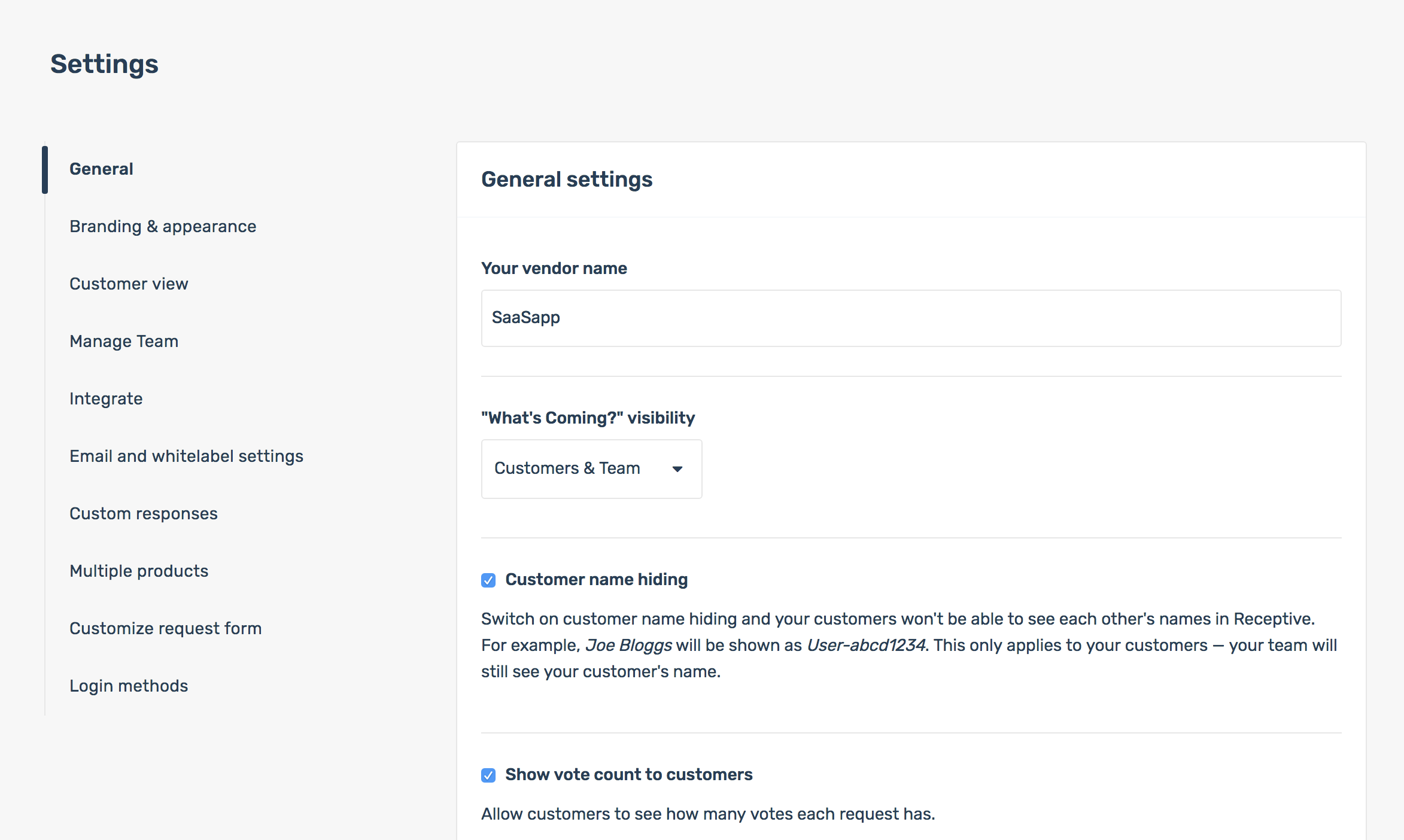
The Receptive settings panel
We also set up the Receptive integration to provide single sign-on for our clients.
Tiffany: We added our logos and we adjusted the colors to make it feel like this was a product that we owned and make our teams feel comfortable with that. I don’t think we made a bunch of customizations beforehand because we really wanted to get the feedback from the teams.
One of the things that we learned was that we needed a code of conduct, something that’s on the widget for our customers to say that other people can see your ideas so be sure to use complete sentences. We were finding that previously when we were hiding the ideas from other customers we would get short sentences or things that potentially our customers wouldn’t want everyone else to see.
Joey: Something we thought about and we rolled with initially is we wanted the experience in our app to be almost white label. We wanted it to appear to be part of our app so we made a decision to only roll with the widget. That’s the primary interface for clients to enter ideas. While they can go to the portal we decided to go with the widget because we wanted it to seem like part of our experience.
One thing that we did leverage heavily during our rollout is the Receptive support team and I can’t say enough about them. It’s really the best way to get any type of technical questions answered that you need.
Tiffany: We didn’t focus so much on the tagging and in training around the tags we thought that would come naturally as we got more into the application and more into usage and figuring out how best to utilize them. Aly was great at suggesting a lot of different options for us and still to this day we don’t really take full advantage of the tagging.
We do take advantage of the products and that was something that we learned from the pilot as well. Which products we needed to be public, which products we needed internally, if we needed internal products, and so that really helped our managers divide up and triage the requests that were coming in.
We did have a little snafu with our rollout when we went external to our clients. We only had one product available on the widget so everything was being tagged as ‘general’ so that was one of the learnings that we found and then we had to fix within the first couple of weeks. That was really the only bump in our external rollout.
Joey: One thing that we did leverage heavily during our rollout is the Receptive support team and I can’t say enough about them. It’s really the best way to get any type of technical questions answered that you need. Obviously we’re in the U.S. so there’s a little bit of a time delay but Rob and the team were always very responsive.
Tiffany: They worked with us with our time differences when we did have things that we needed to be tested. It was great.
What questions did your team members and customers have have when you first launched Receptive?
Joey: I’ll start with the customers because that’s pretty easy.
The user experience is very intuitive so there were no questions basically from our clients. We have been getting a lot of good feedback from our clients saying how they really love the ability to, when they submit an idea, be able to see it, know that it’s been received and tracked, be able to prioritize it, and they can come back and reprioritize it anytime. They really love that aspect of it.
The user experience is very intuitive so there were no questions basically from our clients.
I would say on our team side, our team member side, we got tons of questions.
Tiffany: Yeah and they range from “What do we call it?” to having very specific questions on wanting to be able to customize their Receptive portal to be more client specific.
We had a lot of our service team members in our previous workflow seeing every idea that was coming in throughout the day. They didn’t have to go to another site to view them, they came in via email and they could see which customers asked or submitted an idea, what the idea was, and who had replied to that idea. With the introduction to Receptive we encouraged them that you don’t have to look at every idea as it comes in. There’s a customer portal so you can organize things differently now.
That was kind of a big shift for them so there are a lot of questions around just being concerned that they were going to miss something that their client suggested, and that kind of mind shift. You don’t always have to be aware of everything that your client is suggesting. It’s great to use when you’re talking on the phone but that customers tab is something really important to them and as they got more familiar with that they had some suggestions around “Okay great, now that I’m using this can I favorite my customers so I don’t have to search for them every time?”, “Can I tag myself with these customers so I can run my own report?”. That really helped Joey and I cater some training and teachings for them around those aspects of the tools.
Joey: It is very difficult to anticipate the types of questions that your team is going to ask which is why the pilot is so beneficial, because it really surfaces a lot of those questions. Even after roll out, we’ve been rolled out for two months now, there are still questions coming up, for instance:
- How do I handle an idea that has two distinct ideas in it? What do I do? Do I leave them together? Do I create another idea on behalf of the client?
So there are going to be more things that as a product team you’ll have to decide how you want to handle it and just come up with some policies and then tweak it as you go.
Aly: That’s a really good point! Those workflow items are going to be different for everyone so that’s the kind of stuff that you’ve just got to work with your team on. But then you don’t really know what concerns people are going to have so doing the smaller launch to your internal teams just to get that buy-in and show that you’re not just dumping it on them but you’re learning from them as well, I think it’s going to be really valuable.
Joey: One of the things that we didn’t do with our internal team that we wish we had done is work through the entire lifecycle of an idea.
A lot of people, when we rolled it out to our product team for the pilot and ideas would come in, they looked at it and they’d be like “Okay” and that’s pretty much the extent of what they do.
It wasn’t until they actually had to start going in and changing statuses, responding to clients, making things private when they started asking questions like:
-
If we’re going to use JIRA how does that integration work?
-
How are we going to communicate when an item’s released?
-
Are we going to do it through JIRA, or are we going to do it through Receptive?
All of those things do not surface until you actually go through a complete cycle of idea, development, release, communication. So I would just encourage you to work through that as an exercise because that will save you a lot of the bumps that we ran into when we didn’t know what we were going to do or how we would handle this.

After receiving Joey & Tiffany’s feedback, Receptive ran a live webinar about defining your workflow and communicating it to your teams and customers and why this can be so beneficial. Watch it here.
I would be interested in learning a little bit more about what your workflow looks like.
Joey: This is what we have come up with to run with for the next three months. At the end of three months we’re going to stop and say is this working, do we need to adjust this?
So our expectation is that when an idea comes in we want to make sure that we have looked at it and changed the status and asked any probing questions of the client within the first five days. So we can begin to get comfortable and get ourselves in there working with Receptive.
Next, if we do have a JIRA ticket that we want to associate with the idea we go ahead and link that up.
However, one thing that we decided was that we don’t want to allow Receptive to send out a communication triggered by a change of status in JIRA. Our timing for our release communications when they go out don’t map to when items in JIRA are marked as released. They would actually go out early before we were ready to communicate that, so that was one workflow decision that we had to make when we do have items linked in JIRA.
Our product managers like being able to know that there’s a connection between the idea and the JIRA ticket so that’s something that they enjoy and we do try to use that whenever we can.

Black Diamond’s custom saved responses make it easier for the product team to move items through their lifecycle.
Did you find that initially your product team was a bit nervous or hesitant to actually update the statuses? If so, what did you do to encourage them that it’s okay?
Tiffany: We did find that they were used to responding to one person that submitted an idea. With Receptive people can vote on those ideas and start following those ideas, so instead of responding to that one person who submitted that “Great Idea” (that’s what we call them) you’re responding to maybe 12, 15, 35 followers of that idea. That was a little nerve-racking for them.
Additionally, just trying to decide between a status update or whether this is a comment or a private comment. The whole point of introducing this feature is that we want to communicate with everyone who’s interested in this idea, so a status update is fine.
Receptive creates a very respectful way for customers to communicate with your product team. It has a barrier, you’re still protected, but you’re able to talk and communicate with those customers as well.
We want to be moving things from it’s ‘not reviewed’ to ‘awaiting feedback’ and that doesn’t mean that you’re building that or that the idea is planned. It’s really just “Great, I’ve read this, I appreciate your feedback, we’re going to think about this for a while, if you have any other use cases please just add them as comments.” It’s really just giving a voice to our product management team letting them know that we’re interested in their feedback and and eager to talk and communicate with them.
Joey: Yeah and that could be different for your organization depending on the relationship that your product team has with your customers. For our team it was a paradigm shift because as I said before the primary communication with the customer was done through our service team. There was a little bit of hesitation from the product managers to begin opening that line of communication. One concern was that customers were going to get this new channel direct to the product manager and could ask them all these questions…
Tiffany: … which we haven’t really seen so it’s been good. Receptive creates a very respectful way for customers to communicate with your product team. It has a barrier, you’re still protected, but you’re able to talk and communicate with those customers as well.
Joey: One of the interesting things that we noticed once we put this out in the wild is just the the types of ideas people submit and how they word them. A lot of times people know what they mean in their head so they’ll write a title which really has no meaning to anyone else who’s possibly reading this idea except for the person that submitted it, in the context in which they submitted it.
We spend a lot of time reviewing the ideas that come in, updating titles so that they’re meaningful to our entire population, reading through the idea. I like to, if I see any typos or if I see people using inflammatory language, as our clients tend to do, tone that stuff down and remove it so our product team and our clients aren’t exposed to that type of language. It’s not a bad issue but it does happen from time to time where people are like “You know this feature really sucks you should do a better job on this,” and I’ll just change that to say something else.
Tiffany: Well that’s true. We want to keep all those ideas in Receptive and we want people to be able to view the items that have been released and we want to have that repository of released items and so we want those all to be readable and friendly. If in the future we decide to release items via JIRA that should all make sense. The titles should match the things that we’re building within our application internally and externally.
My concern is that when we open this up we’re going to get feedback that may not be tied to software whatsoever, or it may be tied to software that’s not this particular project. Did you guys face a situation like that?
Joey: Our Receptive account is only for the product that we’re talking about - Black Diamond, the wealth management platform. We know that’s not a problem that we have experienced nor do we anticipate running into. The way that we structure our Receptive set up is that for our product we have different product lines. These are larger features within the product so we have maybe a reporting feature or a data mining or a querying feature. Each of those have their own product in the drop-down so that’s how we manage that. We don’t have disparate pieces of software that people may think that they could submit ideas to.
It’s actually a good way to gauge demand for other areas of your business. If you are getting a lot of ideas for a different piece of software or a different product line maybe it’s time to spin up a channel to allow those clients to give you more focused feedback for that piece of software.
Tiffany: Since we are owned by Advent, and Advent is a subsidiary of SS&C, there are multiple other applications that our clients may use in conjunction with Black Diamond. But Black Diamond has its own brand, its own marketing, and when you’re within that Black Diamond application our Receptive widget is in that application. So it’s very distinct that this is the idea submission for the Black Diamond service and not for any other service that you may be using. We also have a bunch of integrations with other companies and partnerships but since our Receptive widget is within Black Diamond we haven’t really gotten anything specific to those partnerships, or suggestions around that.
Joey: I’m wondering if the source of this question may be coming from some other colleagues who might be a little worried about rolling out a product like this that allows your clients to give you feedback. It’s actually a good way to gauge demand for other areas of your business. If you are getting a lot of ideas for a different piece of software or a different product line maybe it’s time to spin up a channel to allow those clients to give you more focused feedback for that piece of software. If that happened, we would probably mark the idea as not visible to clients and communicate with the client directly that this is not the right place to provide feedback on the specific product.
Aly: That’s really good advice. You can also add a little note on the form, if it does happen, on the form and say hey this is only for this one product. Another option is to actually use a product drop-down that says ‘other’ so if people do submit it they can keep it clear from from your product team.
Did you have any problems with bugs or customer service related issues getting into Receptive?
Joey: One of the concerns we had was that clients are going to use it to send in bugs. We were worried it was going to turn into a case management portal and people are not going to send in ideas, they’re going to send in bugs. Well, that never happened so you never know what’s going to happen until you actually get it out there and then once you do you can manage that process as it comes.
It’s built in a way where you encourage people to communicate in a specific way without actually having to tell them.
Tiffany: I think what happens with Receptive is that customers can see what else is being submitted and so it’s like a follow-the-leader type of reaction. With our old way of getting “Great Ideas” we would get bugs and customer service complaints via that service and we simply don’t see it with Receptive. It’s built in a way where you encourage people to communicate in a specific way without actually having to tell them.
For that first pilot phase what training materials did you prepare, if anything?
Tiffany: We did in-person trainings with Aly, we also sent out a short user guide like, “Hey this is how you get your login, this is what you need to do first.” The only thing we asked of them was that if a client calls and tells you an idea over the phone, go ahead and submit that idea. It was a very low volume approach. We were just concerned about them getting in, submitting some ideas on their own. Our training materials were a page or around that. Same for all three types of pilots.
Joey: Post-pilot we used that retrospective process to understand what people were still confused about or questioning. Then we aggregated all those questions and we made short videos to address those. We wrote an FAQ, and put that in our user guide. I think our user guide was just an overview of the different components and how it maps to their previous workflow.
Tiffany: Yeah things like how to submit an idea, how to vote, how to prioritize. We were mainly concerned with the service team. How do you tell your clients to use this now because it’s more than just opening up an email and writing a description. It’s similar but it’s different, so how do you communicate the benefits? We wanted to make sure that they had the tools needed to submit a “great idea”.
Joey: And telling people one time is not enough. You have to hit them over the head with it 100 times and even then not everyone is going to pay attention to you, so over-communicating was effective for us and our organization.
Then from a rollout perspective and for the clients we created a video and showed them how the experience works within the context of our app, and then talked about some of the the do’s and don’t’s, and the benefits of why we’re doing this. We could communicate the importance of the new tool and how to use it.
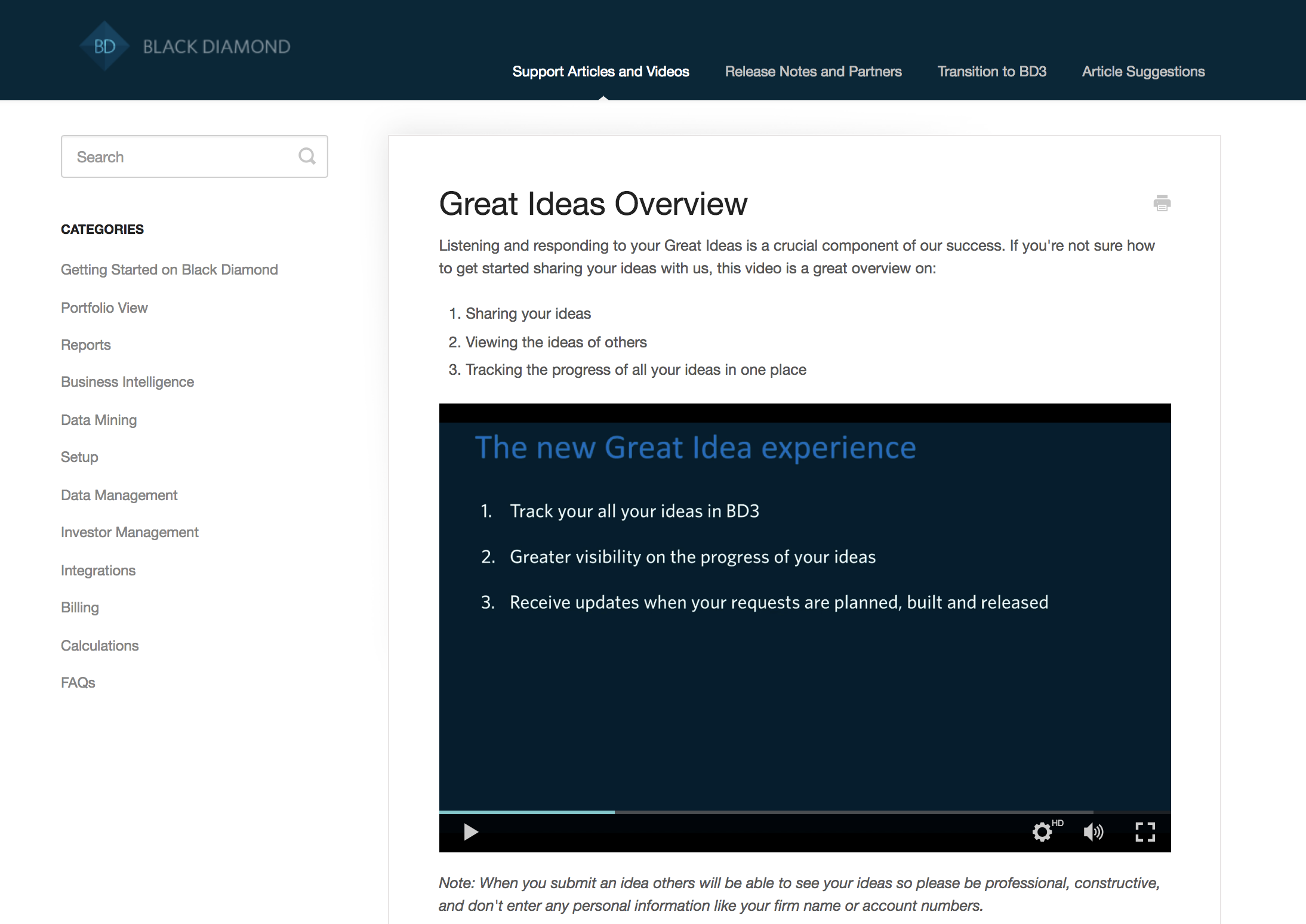 Great Ideas (Receptive) overview in Black Diamond’s knowledge base. Click here to watch a video walkthrough of the full customer experience.
Great Ideas (Receptive) overview in Black Diamond’s knowledge base. Click here to watch a video walkthrough of the full customer experience.
Tiffany: We had really great feedback from the clients. There were just a few people that were like, “Why can’t all my ideas be top priority?” I think that was just a failure in their understanding.
Joey: Now that we’ve rolled out and we haven’t had a lot of questions from clients we’ve shifted our focus back to our internal teams to help them increase their engagement with Receptive. We send out regular emails highlighting new ideas that have come in, reiterating the benefits, why we’re doing this, the benefits to them, the time savings, and benefits to the clients. We use a regular cadence to kind of surface information from inside Receptive out to our external teams so they don’t have to go in and dig around in there because we’ve seen okay engagement internally.
We have great engagement externally so what we’re focused on now is continuing to figure out how we can communicate the value to our internal teams so that they will continue to use it and then be advocates for us to talk to clients about why they should use it.
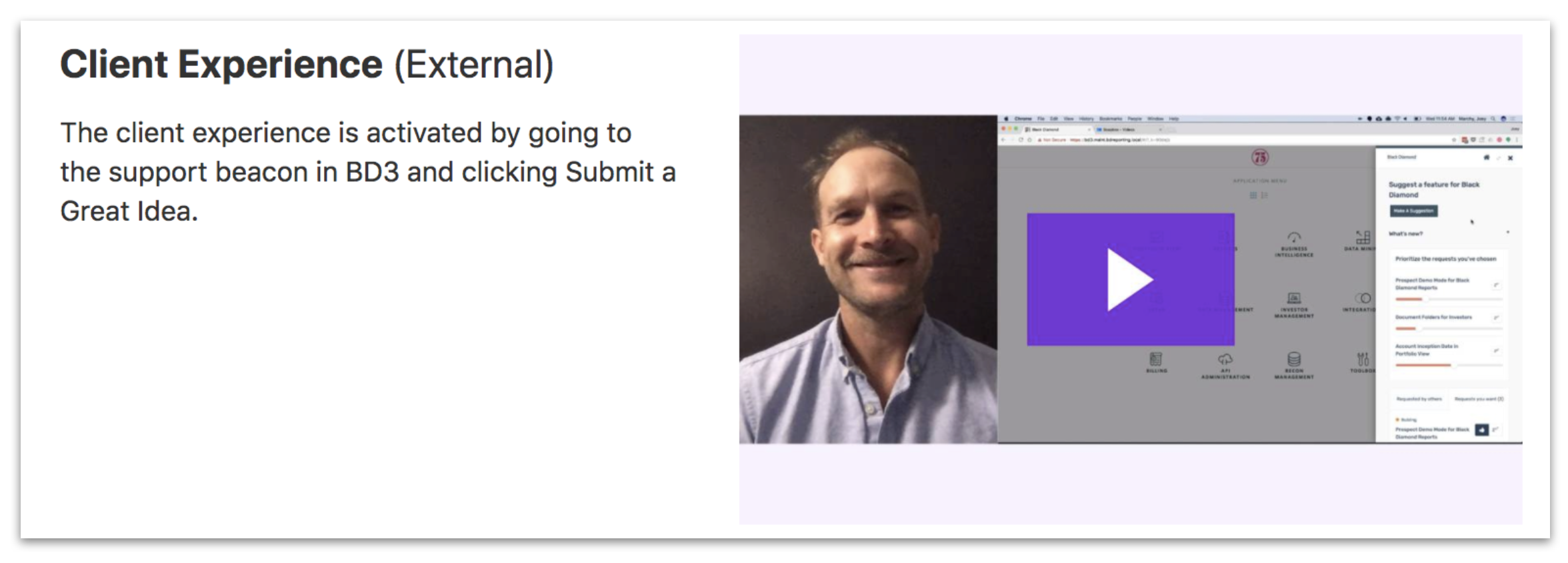 Black Diamond developed short, informative training videos for their customers and teams.
Black Diamond developed short, informative training videos for their customers and teams.
If you re-launched Receptive today, what is the one resource you would prepare for teams and customers?
Joey: Videos. If we could pick one resource that’s what we’d do because a screencast recording your screen and walking through the steps and narrating it communicates auditory and visually way more than any type of in-person training or written article or email.
Aly: What software did you use to record the screen share and the videos?
Tiffany: We used Camtasia and we also used the Wistia platform.
Joey: Yeah that’s a little bit more advanced. Any type of screengrab, I think Camtasia, Screenflow, if you have a Mac you can just simply use QuickTime to record your screen.
Aly: My final question and I think we may have touched on this with the products…
What would you do differently?
Joey: For us it would be getting the widget configured correctly with the products from the get-go. It was an oversight and it put us behind a little bit because of the way that we do releases. If you had the ability to push a hot fix to your production site and not cause any disruption it would not be a big deal but for us we had to wait a week or so before we could get that out. What it prevented our clients from doing was being able to categorize ideas so we had to go back and recategorize a bunch of stuff.
Tiffany: We had great engagement in the beginning so we had a lot of ideas to read. The other thing that I would say is that we spent a lot of time on our service team training and thinking about the workflows, creating documentation for them. We touched on this earlier too but not doing that full idea lifecycle with the product team beforehand was a misstep for us. Doing more of those types of exercises with our product team to answer some of those workflow questions beforehand would’ve relieved some of the anxiety with our product team and helped clarify what their responsibilities are with the tool.
Aly: Travis, any other questions?
Travis: No questions. This has been fantastic, this information. I will definitely take advantage of your insights as we roll it out internally so I’m just grateful that you set this up and to both of you guys thank you for this insight. You’ve no doubt helped our organization a great deal.
Tiffany: We do give Aly a huge shout out because none of this would have been possible without her. We bugged her all the time and she was so, so helpful. Aly was a huge success in our rollout as well you’re lucky to have her.
Aly: We’ve learned a lot from each other, it’s been a team effort for sure. And yeah like I said I really appreciate all three of you taking the time out to hop on this call!
That’s it for episode 2! Don’t forget to tune in next time for a brand new episode of The Feedback Loop!


